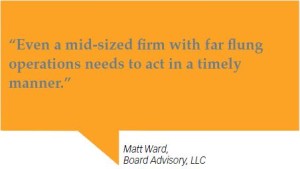The typical discussion regarding executive pay among boards, investors, proxy advisers, and management has tended to be on how much to pay. Executive pay comparisons relate total compensation to both peer companies as well as total shareholder returns. While the “how much” analysis is helpful in assessing relative pay levels, the more critical discussion is how to pay. The “how” discussion describes the way management participates in value created for shareholders. The upshot of this discussion is that if there is agreement on how to pay executives among key stakeholders, then how much to pay is determined by actual performance over time.
The almost exclusive focus on how much to pay is in some respects an accident of history. Prior to WW II, incentive pay was often based on profit sharing. After the war, the market migrated to a competitive pay model that determined compensation based on position, industry, and company size. This had the effect of keeping a lid on pay inflation during the rapid economic expansion and with the elimination of price controls on wages following the war.
Unfortunately, the competitive pay approach led to excesses usually driven by inappropriate peer comparisons. In response, institutional investors have come to the forefront on say on pay. Large institutional investors like Vanguard and Fidelity have established internal groups to evaluate and vote their proxies. Other institutions rely on proxy advisory firms, such as ISS and Glass Lewis. Both the internal groups and the proxy advisers tend to evaluate pay almost entirely on the basis of how much is paid, not on how the pay was determined. Their quantitative models are designed to work across a variety of industries but usually fail to do that (one size fits all doesn’t fit anybody) and often fail to adequately address special situations (e.g., turnaround, companies with few peers, etc.).
The path forward for the say-on-pay evaluators is unclear. The internal groups may face a challenge from within trying to maintain relevancy in an organization whose objective is to generate respectable returns compared to other fund managers in order to attract investors’ savings. It’s a bit odd when a company that makes the fund look good is told its pay is out of line by the proxy group of the same fund. In short, do these groups represent merely an 18-month hitch for a rising executive, or do the Vanguards and Fidelitys of the world see an opportunity to influence investor returns through better pay practices? The proxy advisers have seen their influence diminished through direct institutional involvement. Do these firms morph into IT-driven proxy processors while they rejigger their models to identify only the most egregious offenders of poor pay practices?
In this evolving environment, boards and compensation committees still face the real challenge of ensuing that their compensation program meets with shareholder approval. In response to investors’ concerns about pay and performance, many boards adopted programs with specific metrics and targets that drive both the annual plan and absolute or relative total shareholder return (TSR) performance-based, long-term equity programs. More recently, many companies have developed outreach programs to their large investors.
The challenge that boards face may also be their opportunity. In short, they should create a new discussion about pay practices. Our suggested approach is to define for all shareholders how managers share in the wealth they create for investors. Note the focus is on how, not how much. The former defines the target leverage the program employs—i.e., how does management’s wealth change with a change in the company’s TSR relative to the market or peers? What is the appropriate leverage for an industry, and should the board consider a higher or lower leverage ratio than the company’s peers? This is the right discussion to have with the company’s investors.
When shareholders and directors agree on how managers get paid, then how much they get paid depends only on actual performance. If managers deliver entrepreneurial returns to shareholders, they earn entrepreneurial rewards for themselves; conversely, modest performance produces modest rewards.
– Mark Gressle and Paul McConnell. This article originally appeared in Corporate Board Member magazine, Q1 2015.




